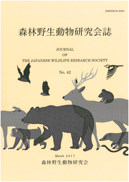Volume 43
Displaying 1-15 of 15 articles from this issue
- |<
- <
- 1
- >
- >|
Original articles
-
2018Volume 43 Pages 1-11
Published: March 30, 2018
Released on J-STAGE: April 01, 2021
Download PDF (849K) -
2018Volume 43 Pages 13-18
Published: March 30, 2018
Released on J-STAGE: April 01, 2021
Download PDF (1117K) -
2018Volume 43 Pages 19-25
Published: March 30, 2018
Released on J-STAGE: April 01, 2021
Download PDF (820K)
Short communications
-
2018Volume 43 Pages 27-30
Published: March 30, 2018
Released on J-STAGE: April 01, 2021
Download PDF (817K) -
2018Volume 43 Pages 31-35
Published: March 30, 2018
Released on J-STAGE: April 01, 2021
Download PDF (1257K) -
2018Volume 43 Pages 37-45
Published: March 30, 2018
Released on J-STAGE: April 01, 2021
Download PDF (1441K) -
2018Volume 43 Pages 47-51
Published: March 30, 2018
Released on J-STAGE: April 01, 2021
Download PDF (797K)
Materials
-
2018Volume 43 Pages 53-54
Published: March 30, 2018
Released on J-STAGE: April 01, 2021
Download PDF (328K) -
2018Volume 43 Pages 55-73
Published: March 30, 2018
Released on J-STAGE: April 01, 2021
Download PDF (3527K)
Reports on the open symposium “The problems of wildlife in Niigata Prefecture”
-
2018Volume 43 Pages 75
Published: March 30, 2018
Released on J-STAGE: April 01, 2021
Download PDF (124K) -
2018Volume 43 Pages 77-79
Published: March 30, 2018
Released on J-STAGE: April 01, 2021
Download PDF (1003K) -
2018Volume 43 Pages 81-83
Published: March 30, 2018
Released on J-STAGE: April 01, 2021
Download PDF (280K) -
2018Volume 43 Pages 85-92
Published: March 30, 2018
Released on J-STAGE: April 01, 2021
Download PDF (941K) -
2018Volume 43 Pages 93-99
Published: March 30, 2018
Released on J-STAGE: April 01, 2021
Download PDF (481K)
Book review
-
2018Volume 43 Pages 101-102
Published: March 30, 2018
Released on J-STAGE: April 01, 2021
Download PDF (478K)
- |<
- <
- 1
- >
- >|
